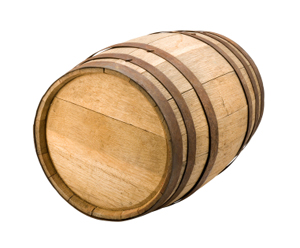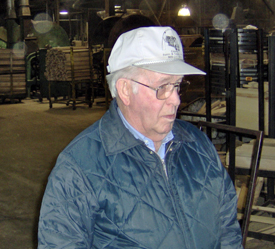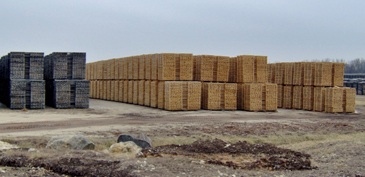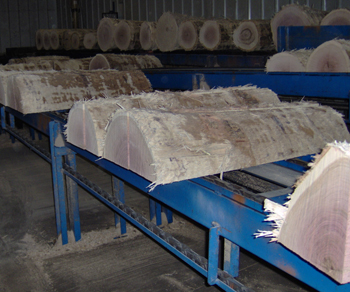

As any winemaker will tell you, the type of wood used to make barrels is a major determinant in how the wine will develop.
You Want Wine Barrels - Missouri's Got Your Wood
Why would wineries from around the globe source their wine barrels from little Cuba, Missouri? McGinnis Wood Products, that's why.
by
Tim Pingelton
March 27, 2008
 cold winter rain is lightly falling all over the Ozark Highlands in central-eastern Missouri. Everything is wet and cold: all of Crawford County; all of Cuba, Missouri; and all of the neatly stacked wine barrel staves - thousands of them - surrounding McGinnis Wood Products. I listen to raindrops on the windshield before hurrying into the corrugated metal building. Inside is dry (though not warm), and, although it was Saturday, the sounds of banging, grinding, and sawing emanate from the “shop.”
cold winter rain is lightly falling all over the Ozark Highlands in central-eastern Missouri. Everything is wet and cold: all of Crawford County; all of Cuba, Missouri; and all of the neatly stacked wine barrel staves - thousands of them - surrounding McGinnis Wood Products. I listen to raindrops on the windshield before hurrying into the corrugated metal building. Inside is dry (though not warm), and, although it was Saturday, the sounds of banging, grinding, and sawing emanate from the “shop.”
Don McGinnis meets me kindly, and we go into his father’s office. Leroy McGinnis is wearing work clothes, as is Don. They speak plainly with full eye-contact. Leroy asks me to have a seat. A modest TV is on. “It’s race day,” Don explains.
McGinnis Wood Products has the largest inventory of air-dried wood in the United States and the largest inventory of air-dried white oak in the world. The demand for wine barrels

Leroy McGinnis sells barrels around the world from his facility in Cuba, Missouri.
“We’ve got the number one wine barrel in California,” Don modestly states. His father says, “We have barrels all over the world. We do a lot of business in Spain and Australia. And Hungary.” So, why locate in Cuba, Missouri (population less than 5000)?
“Poor soil and rocky ground. We’ve got the slowest-growth timber in the state. Slower the growth, the better the wine because you have more growth rings. [Air] penetrates better,” explains Don.
French oak, the other principal wood used in wine barrels, has farther spaced growth rings. The staves of a French oak barrel are consequently thinner than that of Missouri oak because air penetrates more readily through Missouri white oak than French oak. Slight, predictable air penetration, referred to as oxygenation, benefits wine by balancing out hot alcohol impressions and, frequently, providing the atmosphere for the conversion of harsh malic acid to smoother lactic acid compounds in wine. Red wines and some whites are also barrel-aged to impart vanilla and other profiles generated from the toasted inside of the barrel. Crisp whites are usually fermented and stored in stainless steel tanks to maintain their fruitiness and freshness. Don and Leroy discuss French and Missouri oak.
Don: The French wine staves are hand-split because they’re thinner. … It’s a totally different process. The grain in French oak crosses, it’s porous.
Leroy: The beads are open. They’re just like straws. This wood [pointing to a barrel he made from Missouri white oak] has tylosis in it. Their wood doesn’t.
Don: If you go out in a field and break off a piece of grass, it’s got that white stuff in the middle of it. If you look with a magnifying glass, that’s what ours looks like. If you look at the end of a French oak stave, it looks like a soda straw. There’s nothing; it’s wide open. Same with Hungarian oak.
What Missouri Wood is Best For
McGinnis wood is harvested solely from a small area in south-central Missouri. What doesn’t make the grade for wine barrels is used for whiskey barrels. Leroy explains the process of what happens after logs are brought to their property:“In our green-mill organization, we separate everything, and what we can put in wine, we separate out and stack it out to air dry. About 50 percent of what we cut isn’t good enough for wine, and we set that back for bourbon barrels for Jim Beam and Heaven Hill. We run those right through the dry kilns because they don’t really cure; you can put them straight in from the green-mill. We do out sorting at

A small portion of wine barrel stave stacks surround McGinnis Wood Products. Each stack has 600 staves,
enough for about 20 barrels.
Leroy McGinnis runs a multi-million dollar, international company, and all of his deals are secured with only a handshake. The one time Leroy signed a contract brought lawyers and broken trust on the other side of the deal. He chuckles.
"I had a company come along and offer me money [for exclusive right to his staves]. I said, 'No, I don’t want to do that.' He said, 'What if somebody comes along and offers you more money?' I said, 'They do that every day.'"
McGinnis comments: “We have a good arrangement - nothing on paper, just an agreement. The only deal we have is that when I ship, I want my money. When we ship 2 containers to Spain on Friday, we’ll have the money in the bank by Tuesday. In 20 years, that hasn’t failed."
"We’ve had very good luck with that 53-gallon barrel, which is all we make here. We sell those especially in the north and the east, and we don’t reach farther than that. We have had a great relationship with a French company [Demptos] in Napa. I’ve had a long-term relationship with them - about 18 years with no contracts. They are the only French company that has total access to American wood without a penny invested in it. Whether I ship to France or Spain, wherever I ship, they have not failed me. We just have word of mouth agreement.”
Seeing the Forage from the Trees
Leroy gave me a full tour of the shop where the barrels are made. Despite crazy cutting and sanding machines, tall stacks of wood, and open fires to toast the barrels, there has been only one injury in the shop, and that was due to a careless, foolish worker. “We had all kinds of awards for safety. We really push the issue,” Don said.The specially-cast iron machinery looks from another era. Leroy agrees.
"Our place is old-time, but we’re getting ready to put up a new 20,000-square foot building to move all of our wine deals into and get it out of here. Always worry about a mix-up with our bourbon wood and our wine wood, and we try to be very careful, but things happen. Well, they never have, but I worry, so we’re going to get plum out of this building . . . my grandson and Tommy are leaving Thursday for Bangkok. You can hardly get casting done here anymore. We haven’t had a debt since 1992, and we never stop building.”
Before Leroy takes me on a tour of the “inventory” outside, we stand in a large open doorway and watch the rain falling on stacks and stacks of wine barrel staves. Bourbon barrels go straight into the kiln after cutting. “Thirty-five days, 37 days after we buy a log, we have a bourbon barrel,” Don states. “With kiln dried wood, you lock the acids into it. I’m not really a wine drinker - we raised 5 kids and worked all the time - but I’m a heavy

This Missouri white oak at McGinnis Wood Products will be wine barrel staves in a
 READER FEEDBACK: To post your comments on this story,
click here
READER FEEDBACK: To post your comments on this story,
click here
Print this article | Email this article | More about Missouri | More from Tim Pingelton













